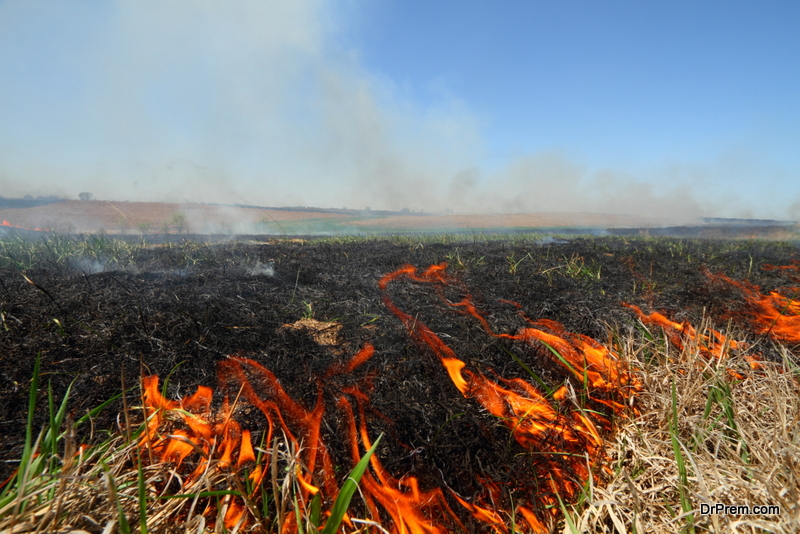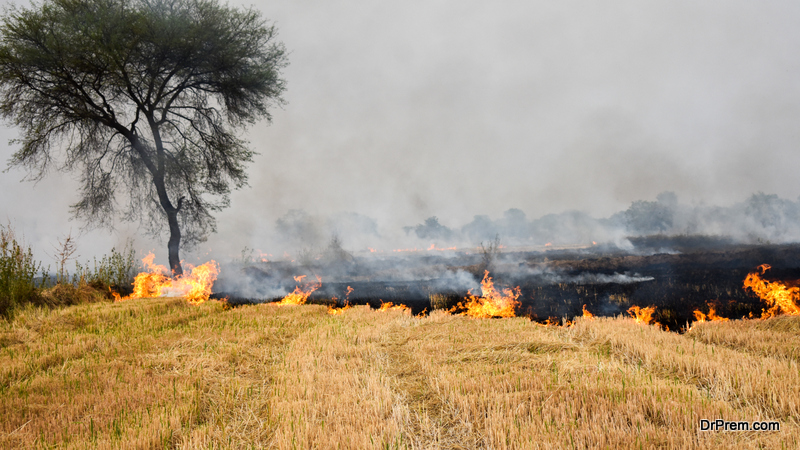Every year in the months of October and November, the farmers in Punjab, Haryana and western UP burn the straw stubble which remains after wheat, rice and other grains are harvested. This burning of the dry straw releases particulates and pollutant gases into the atmosphere and people in the surrounding areas including the national capital suffer immensely. The nitrogen oxide and carbon monoxide which form smog drift over the Indo-Gangetic plain. The farmers have to bear the brunt of it, and are doubly affected, by the pollution and the loss of nutrients such as Potassium, Phosphorus, Nitrogen and Sulphur in the soil. Let’s take a closer look at the stubble burning issue and what could be the solution:
Stubble burning: Why does it happen every year?
Decrease in time gap between crop cycles
 Cities, towns and villages in the entire region choke every October/November and it takes the whole year for the air quality to improve. Come October, the cycle starts again.
Cities, towns and villages in the entire region choke every October/November and it takes the whole year for the air quality to improve. Come October, the cycle starts again.
Interestingly, stubble burning is a problem which arose as a result of the government trying to promote green agriculture. To stop stubble burning is not an easy task. Even though farmers may want to stop burning the crop waste, they would need help from the government to manage the waste without burning.
The problem has increased as the governments have mandated that rice planting in Haryana and Punjab should coincide with the beginning of monsoon, i.e. early July. Punjab government has a law that prohibits farmers from cultivating paddy before the date decided by government.
Therefore, the cropping periods of Kharif as well as Rabi have come extremely close. There is only a gap of about fifteen days before the crops cycles, when farmers have to remove the stubble to prepare their fields for the next crop.
The easiest way to do that is crop residue i.e. parali or stubble burning. Burning the crop residue is also the cheapest way to prepare the fields in such a small time span.
Besides, HYV rice residue is not as palatable as animal fodder as the basmati residue. Farmers have no use for the residue (as they see it) and so they burn it, even though they themselves suffer from the pollution and their soil nutrients also decrease.
Earlier, when harvesting was done by hand, farmers used to cut the crops at the roots, leaving behind a much shorter stubble. But industrialization has changed all that.
Threshing, cleaning and cutting of grains are done using rotating blades, elevators, wheels, and sieves. Harvesting done by machines, such as combine harvesters, especially in UP, Haryana and Punjab, leaves behind taller stubble about one foot tall.
In UP’s Chandauli and Zamania areas, parali or stubble burning occurs on a large scale. There are fatalities too, as can be seen from the incident when a farmer perished in his own field while burning the wheat stubble.
Health and environmental fallout
The burning of stubble is responsible for haze over cities such as Delhi and to the melting of the Himalayan glaciers.
According to one study, burning stubble releases 149.24 million tons of CO2, 0.25 million tons of SOX (sulphur oxide), 9 million tons of CO, 0.07 million tons black carbon and 1.28 million tons particulate matter. This creates breathing and respiratory problems for everyone, including children and the elderly.
According to one study, stubble burning revealed that 84.5% people suffer from health problems due to increased smog. 76.8% people suffer from eye irritation and 44.8% people have irritation in the nose. Irritation in the throat is also quite common, with 45.5% having throat irritation.
Wheezing and coughing also increases, with 18% suffering from wheezing and 41.6% suffering from cough. In the farming belts of Punjab, the villagers spend almost 7.6 crore on treating ailments due to the atmospheric pollution.
The soil does not stay unaffected either. The heat which emanates from the burning seeps into the soil upto 1 cm depth, increasing the temperature of the soil to approx 42.2 degree Celcius.
This increased temperature kills the fungal and bacterial populations which are critical for fertile soil. Thus, this is another reason to stop stubble burning as the micro-organisms present in upper layer are damaged.
The loss of these friendly organisms and pests has led to more attacks of the harmful pests which makes the crops prone to disease and devastation by pests. Solubility capacity of soil is reduced drastically.
One ton of stubble which is burnt lead to loss of soil nutrients such as 5.5 kg nitrogen, 25 kg potassium, 2.3 kg phosphorus, 1 kg sulphur as well as organic carbon. This loss means that farmers have to introduce synthetic fertilizer or chemical fertilizer to the soil to induce faster growth.
What should be the governmental action?
 On the 10th of December 2015, the NGT or National Green Tribunal had banned the burning of parali in Punjab, Haryana, Rajasthan and Uttar Pradesh. Burning stubble is a crime under Section 188 of IPC under the Air and Pollution Control Act, 1981.
On the 10th of December 2015, the NGT or National Green Tribunal had banned the burning of parali in Punjab, Haryana, Rajasthan and Uttar Pradesh. Burning stubble is a crime under Section 188 of IPC under the Air and Pollution Control Act, 1981.
Delhi High Court had also ordered against the burning of residue and in 2016, Punjab’s government had collected fines to the tune of 73.2 lakhs from the famers. But even these measures have not deterred the farmers from burning parali every year, leading to toxic air and soil pollution.
Taking stern action against the farmers who do not follow the ban is one solution, but the government has been lax in this matter. The issue is more complicated, as the farmers are willing to pay the fines rather than stop burning the residue. There has to be more positive action to convince farmers to stop the parali burning every year.
What the solutions or alternatives to stubble burning?
Spreading awareness of alternatives
The central and state governments have to work consistently using print and electronic media, street plays and so on, to spread awareness about the harmful effects of burning stubble. The farmers have to be educated about the alternatives they have in using the stubble for their benefit.
Stubble or parali can be used as compost, cattle feed, roofing in the rural areas, mushroom cultivation, packing material, etc.
The straw or stubble which is left behind can be used to make biofuel/bioethanol, paper, industrial production and so on. These choices should not be just on paper, but the government and NGOs should motivate government bodies and private individuals to make productive use of the biowaste.
Facilities to produce bioethanol should be set up in the vicinity and there should be collection points where farmers can leave the stubble. An incentive would be to pay the farmers for the waste straw. This is one of the best solutions to stubble burning.
Solution devised by the IIM-A students
 Students from the IIM-A studied the problem of parila burning and came up with viable ways to use the leftover paddy straw. The farmers would also earn money from their waste straw rather than burning it, creating pollution and earning nothing from it.
Students from the IIM-A studied the problem of parila burning and came up with viable ways to use the leftover paddy straw. The farmers would also earn money from their waste straw rather than burning it, creating pollution and earning nothing from it.
The study was conducted by the students Shivam Rana, Sawan Khapne and Shaliendra Singh who dwelt upon the various method of utilizing the crop waste. The study was conducted from the months of July to September.
The students visited Amritsar’s Khot Khalsa area and met with the farmers of that area to get a grasp of their problems, and their reasons for stubble burning.
Though the farmers acknowledged that they did know about the harmful effects of burning the stubble, they continued to do so as it is one of the cheapest and most convenient ways to get rid of the waste.
The students proposed gasification process of the stubble, mushroom cultivation, manufacturing bio-concrete for building construction. The biochar can be used constructively in the production of biofuel and the students focused their attention on the 31 villages in Verka, near Amritsar. These villages were further divided into four clusters for easy collection of the paddy waste and distribution of the equipment.
The study supervisor stated their aim was to develop a particular pattern which could be followed as the paddy is harvested. They suggested the setting up of service providers (NGOs) who would collect the paddy and transport it to the markets or processing units.
To avoid stubble burning, supply chains have to be set up which can penetrate into the rural areas, into the villages of the affected states. The stubble can be removed with the help of daily wagers or laborers who are engaged by the co-operative societies and government societies. The farmers could be paid for the straw which would then be transported to the facilities.
Financial incentive would be an attractive option for the farmers to stop burning the stubble.
In the year 2014, the National Policy for Management of Crop Residue was released by the Union government. Since that time, the farmers which followed the guidelines managed to make their soils fertile naturally by using the crop waste as fertilizer. Mulching/composting is the process by which the dry parali can be turned into fertilizer. There was a saving of 2000 rupees per hectare as the farmers saved on the manure cost.
Using machinery
Another solution to stubble burning is by employing agricultural machines such as the Happy Seeder, which can sow seeds even in standing stubble, the Rotavator can be used for preparing the land and incorporating crop stubble in soil. The Baler can be used for the collection of the straw, and also for making bales out of the paddy stubble.
Zero till seed drills are an agriculture machinery which can be used for the land preparation and directly sowing of seeds in the previous crop’s stubble. Reaper Binder is a machine which can be used for the harvesting of paralia or crop stubble and making it into neat bundles. The Paddy Straw Chopper cuts paddy stubble which can then be mixed easily with soil.
All these machines are expensive and most of the farmers cannot afford them. The state governments have to grant more subsidies so that medium and small farmers too can buy these machines. The government says that it provides 50-80% subsidy for crop residue managing machinery. Rs. 1,151.80 crore has been allotted for the states of UP, Haryana, Punjab and NCR.
A study by Science found that the use of the Happy Seeder machine which is tractor mounted, and attaching straw shredders to their harvesters and leaving the straw on the fields is highly beneficial for the soil, as it captures moisture thus improving soil quality.
The study proved that it is quite possible to reduce the harmful greenhouse gases emitted by stubble burning by using the Happy Seeder machinery, and leads to 10-20% more profit for the farmers.
The Indian government has offered a 166 million dollar subsidy to the farmers to access the Happy Seeders and other machinery which can solve the problem of stubble without burning.
Priya Shyamsundar, the author of this study, and Lead Economist, Global Science and with The Nature Conservancy, noted that the number of farmers using the Happy Seeder were few. The production of the machine has increased over the years. Though the machine is currently available, farmers do not use it due to the lack of awareness. Therefore, spreading awareness should be the main concern of the NGOs and the government.
The role of state governments – are they providing enough support?
 According to the state governments, they are providing mulchers as well as choppers and other machinery to farmers at subsidized rates. But still, we see the dreaded phenomenon of stubble burning occurring every year in the same months of the year. Why is this so?
According to the state governments, they are providing mulchers as well as choppers and other machinery to farmers at subsidized rates. But still, we see the dreaded phenomenon of stubble burning occurring every year in the same months of the year. Why is this so?
Farmers say that the financial aid promised by the state governments is only on paper and they have yet to see it. They are therefore compelled to burn the stubble on their farms. Members of Kisan Morcha sat in protest outside the Sangrur Deputy Commissioner’s office as the government failed to provide the machinery to manage farm waste.
The entire agriculture department and state machinery have to be more proactive and held accountable for stubble burning, especially when the machinery and finance support does not reach the farmers who are willing to make the change.
The manufacturing of machines such as the Happy Seeder has to be stepped up, as these are acceptable to the farmers. The cost of the machines should also be reduced further. For example, the Happy Seeder is priced at 1.5 lakhs and even after 33% subsidy, it is beyond the capacity of many farmers to buy.
To save humans and the environment from the plague of stubble burning every year, the agricultural waste management machinery, which seems to be the best option, has to be made available for rent or at nominal prices, and stop the annual burning of stubble.




